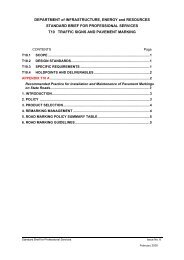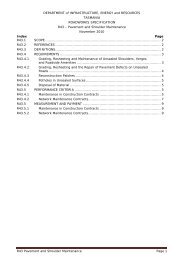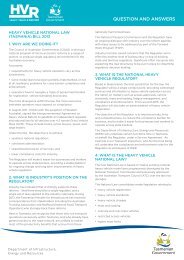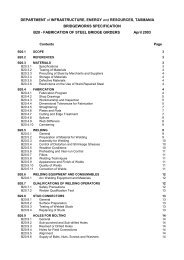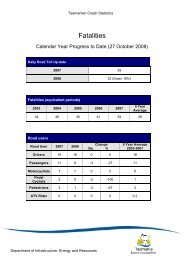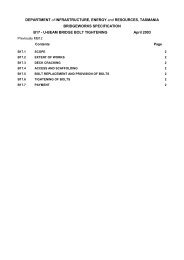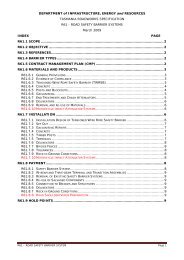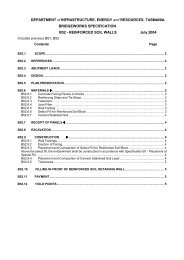Public Environment Report Tarkine Forest Drive ... - Transport
Public Environment Report Tarkine Forest Drive ... - Transport
Public Environment Report Tarkine Forest Drive ... - Transport
- No tags were found...
You also want an ePaper? Increase the reach of your titles
YUMPU automatically turns print PDFs into web optimized ePapers that Google loves.
The <strong>Tarkine</strong> <strong>Forest</strong> <strong>Drive</strong> significantly aligns with the Corridors element. Corridors aredefined as existing access routes extending throughout the <strong>Tarkine</strong>, each of whichshould be “developed as a series of experiences linked together, rather than a‘highway’ through the <strong>Tarkine</strong>”.The South Arthur <strong>Forest</strong> <strong>Drive</strong> is identified as one of the five corridors. TheDevelopment Framework notes a proposal to seal the existing gravel sections of theSouth Arthur <strong>Forest</strong> <strong>Drive</strong> through to Arthur River Township and to name it the “<strong>Tarkine</strong><strong>Forest</strong> <strong>Drive</strong>”. Because the current project aligns precisely with the suggested corridorworks, it is appropriate that this project assumes that name. Accordingly, the projectis referred to as the <strong>Tarkine</strong> <strong>Forest</strong> <strong>Drive</strong>.The merit of the project is recognised because:The main road corridor and visitor sites are already in use by travellers andcommercial operatorsIt would provide an enhanced tourist circuit, with consistent signage and visitorfacilitiesIt would establish the critical mass needed to launch this part of the <strong>Tarkine</strong> as amulti-day destination.The Development Framework goes on to suggest some specific additional touristinfrastructure development, such as parking and day use areas, which could bedeveloped as part of the South Arthur <strong>Forest</strong> <strong>Drive</strong> corridor.Other studiesAs part of the North West’s Regional Development Strategy, the Cradle Coast Authorityand Tourism Tasmania established ‘The Great Nature Trail’ as a way of enhancing theattractiveness of the journey to a potential cluster centred on Stanley, Smithton andDismal Swamp.Since its establishment, a number of regional tourism studies, such as the StanleyTourism Precinct Study and the Tasmanian Experience Strategy, have identified thatthe Great Nature Trail cluster has some serious issues in terms of branding:A lack of experience-rich productsPoor conversion of day visits to overnight staysExposure to downtrends in key market segmentsA heavy reliance on Stanley as the main drawcard.Key findings of the research identified the opportunity to develop experiences basedaround the cluster’s potential strengths in wildlife, wilderness walks, the coast, foodand beverage. The <strong>Tarkine</strong> Wilderness Experience was identified as a key developmentopportunity for the region.According to Tourism Visitor Survey data, in the past four years there has been an 11%drop in visitor numbers on the Great Nature Trail. There is also a clear reduction invisitation rates with distance westwards from Burnie.Both facts indicate that the Great Nature Trail has become less competitive due to alack of attractions and the need to ‘back-track’ to Burnie to connect with otherestablished touring routes such as the Wilderness Touring Route to the West Coast.Considerable recent independent research and expert advice supports the view thatthe <strong>Tarkine</strong> offers Tasmania the opportunity to recapture its pre-eminent position innature-based tourism in the national market.Ref: HB09080H001 PER <strong>Tarkine</strong> <strong>Drive</strong> 33P Rev 00/DL/CL/jw 8



